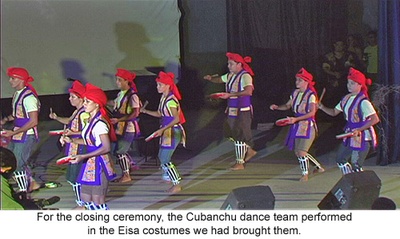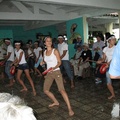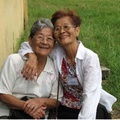>> Part 3
On Saturday, our last full day on Isla de la Juventud, we returned to the movie theater in the morning where a kenjinkai “show and tell” of sorts had been planned. It was an opportunity for the delegations to talk about their respective kenjinkai and the kinds of activities and classes they hold to keep the Uchinä spirit alive. The main idea was to show the Cubanchu how they could organize the same types of activities.
Early on, our delegation had decided to present the video greetings I had gathered to show the diversity among the North American kenjinkai, especially our geographical range. It was also an opportunity to let the Cubanchu know that even though there were only seven of us representing North America, we brought with us well wishes from across the continent.
Playing the greetings seemed simple enough. We just needed a VCR and a television monitor to play the VHS tape containg the video messages from the various kenjinkai. As it turned out, it wasn’t a simple task after all. Once we found a VCR and a television in a back screening room, we had to make sure the VHS recording was suitable for watching. That is where something got lost in translation. I don’t speak Spanish so I wasn’t able to tell the person making the copy exactly where to the start the dub. After going through the entire VHS tape, I found that the messages weren’t there. Luckily, I still had the original tape with me and was able to use another video camera to play it.
We also had to figure out a way to set up the television set so that everyone could see it. We found an outlet in the theater box office but needed an extension cord to plug it in. Another hunt ensued. At one point, there were nearly 10 of us trying to get everything together. Finally, about an hour later, the theater employees managed to get the television set up in the main auditorium. Everyone had pulled together and the audience was finally able to see and hear the greetings. I saw smiles on faces as they watched Wesley Ueunten deliver the San Francisco Kenjinkai’s greeting. The crowd even joined the Chicago Kenjinkai in singing “Asadoya Yunta.”
Even more touching was the message our group leader Akiko had recorded of former Isla residents Marielena Uehara and her 90-year-old mother Esperanza, who is Cuban. They left Cuba in the 1960s and had never returned. In the message, Marielena introduced her children and reminisced about her childhood in Isla. As I continued to videotape reaction to the messages, I noticed tears falling from the eyes of the people in this tight-knit community. For those who remembered Marielena’s family, it was a sentimental moment to see a family they had known and missed; for others too young to have personally known them, it was a connection to one of their own living now outside of their country.
After the morning program, we broke for lunch. The visiting delegations boarded their buses and headed back to their hotel for lunch. I found it rather odd that we could not enjoy our meals with the Cubanchu. We could mingle amongst ourselves while we ate, but we did not have the same opportunity with the Cubanchu.
After lunch, we returned to the theater for musical performances. A trio from Mexico City did an instrumental performances with a modern twist using the koto, piano and flute. They were followed by Okinawan artist Toru Yonaha who put on an impressive show with his sanshin and powerful voice.
We parted once again to return to our hotel for dinner. We had heard that the closing ceremony, which would be held back at the theater after dinner, would feature a number of performances that excited us, among them Kachimba 1551, a popular Latin band from Okinawa. Several of the band members are Peruvian Okinawan. Two members of our group planned to join the Eisä dance team for the song “Asadoya Yunta.”
After dinner, it was back to the theater for one last time. As soon as we got there, three of us rushed backstage. Chitose, with the Mexico delegation and an organizer, was already helping the dance members with their costumes. They were so excited and happy to be wearing the Eisä outfits we had brought for them. They walked around with huge smiles on their faces. There were no mirrors backstage, so at one point they used the back of a DVD to look at their reflections. Since I had a screen on my video camera, I flipped it over so they could see themselves. For me, being backstage and witnessing the excitement was the defining moment of this trip. It made the past few months of work worthwhile.
We enjoyed more of the local Cubanchu talent during the closing ceremony. The first number of the closing ceremony was “Asadoya Yunta” performed by members of the Cuban dance team, along with Yuko and Eva from our delegation. Professor Akira Iha from Okinawa, accompanied on sanshin by Narryman, provided the live music. During their next song, “Tinsagu Nu Hana,” the shïsä (lion-dog) came on stage. The shïsä costume had been a gift from the Tsukimi Kai group that journeyed to Isla earlier in the year. It was inspiring to see the dancers carry on what they had learned, realizing also that there is much more for these young students to learn.
The dance team looked marvelous in their new costumes. Their colorful wardrobe gave their performance an extra flair. Realizing that we were part of their transformation was a proud moment.
The group Kachimba was the final act. They invited other local musicians to join them. Okinawan pop musician Toru Yohana also joined them, rocking his sanshin like I’ve never seen before. They closed the program with a lively kachashi, getting nearly everyone dancing on stage, officially closing the Cubanchu centennial celebration.
The next morning, we were booked on early flight back to Havana. Although we were on the island for only a few days, it was hard to leave. This was the first time that Cuba’s Uchinanchu had organized an event that involved others outside their community, so it had been a major undertaking for them. Despite the amount of work, the Cubanchu had opened their hearts to us. I don’t really know why, but I definitely left with a heavy heart. Perhaps it’s because I still had so many questions about the Nikkei lifestyle in Cuba. As we boarded the plane back to Havana, I knew I had to save them for another time.
Back in Havana, we spent the rest of the day sightseeing with Jesus. We visited Ernest Hemingway’s house, now a museum situated on a sprawling estate. Unfortunately, they charge $50 to bring in video cameras; $5 for still cameras. We learned that Hemingway was obsessed about his weight; he weighed himself nearly every day and kept a record of his weight on the wall. He built a special room for all of his cats; these days, however, friendly dogs have run of the property.
Monday, our last day in Cuba, came all too soon. I wanted to stay a little longer to absorb more of the Cuban culture. Even though the public restrooms lack running water, toilet paper or soap, there was something endearing about the country. I can’t quite put my finger on it. Maybe it was the people, or the music that can be heard everywhere. Maybe it’s the country’s history that I find so fascinating.
MISSION ACCOMPLISHED
As our plane departed Cuba, I looked out the window and took my final glimpses of Havana. What a difference the week had made, I thought to myself. Before I actually got to Cuba, the focus was on helping the Cubanchu keep their Okinawan cultural traditions alive. As it turned out, however, it was the Cubanchu who inspired me. What they taught me about their country and their way of life will remain with me forever. Their resilience and resourcefulness are qualities I came to admire about them.
It was the little stories that said so much about the people we met, like the “thank you” from Cesar Masaki, a 23-year-old member of the dance team, after the closing ceremony. He walked up to me, extended his hand and simply said, “Thank you for everything.” It was an expression of appreciation filled with sincerity.
I heard about Nancy’s story only after I returned to L.A. Nancy Oropeza, a woman we met in Isla, was at the airport to greet us the day we arrived. On the day we were scheduled to return to Havana, she left her home at 4 a.m. and walked for an hour and a half before finally hitchhiking to the airport to see us off. These are some of the stories that I will share with people who ask me about Cuba and the Cubanchu. Stories I will never forget . . .
* This article was originally written as a special to The Hawai‘i Herald.
© 2008 Lesley Chinen







